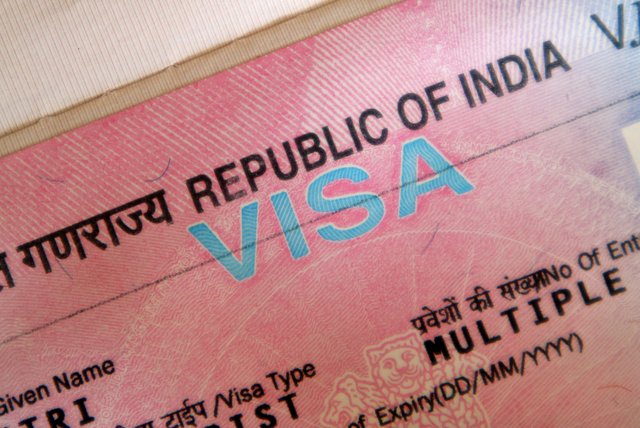Are you ready to embark on a journey of a lifetime and tick the ultimate travel destination off your list? India is one of the most popular travel destinations in the world, a country everyone should experience at least once. Before you book your ticket and pack your bags, you must first find out what documents and papers you need for Indian Visa to enter the country as a tourist.

In this article, we will explore everything you need to know about Indian Visa. This includes what type of visa you will need based on your nationality and the kind of trip you are planning, how to obtain it, and the fees you can expect to pay.
Before we delve into the technicalities of India’s entry policies, let’s first take a look at what makes India such a special destination for visitors, and why it should be at the top of your travel bucket list.
Why You Simply Must Visit India, in a Nutshell
Firstly, India’s geography is incredibly diverse with arid desert, palm-fringed beaches, dense forests, and some of the tallest peaks in the world. The diversity of its landscape means you can enjoy a huge variety of breathtaking scenery and outdoor activities across this vast country.
Next, it’s not only the intricate landscape that draws people from all over the world to India, because the country’s rich culture is reason alone to visit. North to south and east to west, you will encounter different traditions, rituals, and ways of living that will keep you coming back for more.
As if this was not enough, India also offers bustling cities, countless ancient monuments, and exciting shopping opportunities around every corner. History buffs will be in their element exploring the old forts of Rajasthan and marveling at the Taj Mahal. Meanwhile, the colorful textiles and exquisite jewelry will be fighting for your attention wherever you go. Every city is a sensory experience in every way imaginable, something that will stay engraved in the memory forever.
And finally, we mustn’t forget India’s pièce de résistance: the food! No matter where you are or what you are doing, the promise of vibrant cuisine lingers in the air everywhere you go. Indian food is packed with such depth of flavor and tantalizing spices that it so often becomes a highlight of the whole experience. You can expect a generous amount of heat from most dishes, so you might want to prepare your taste buds for some spicy deliciousness before you go.
Exploding Wellness Tourism in India

In 2019, India’s vibrant colors attracted over 10.5 million people, making it one of the fastest emerging tourist destinations in the world. Bangladesh, the United Kingdom, and the United States have been the top three countries with the largest number of visitors to India for some time now. This is so much so that the three countries combined make up almost half of all visitors yearly. This sector is an extremely important source of income for India, with 87 million people working in travel and tourism.
On top of history, culture and all the things we already mentioned, there is a unique kind of tourism taking over in India. We are talking about wellness tourism, rooted in the country’s spirituality, attracting millions of people every year. Yoga and meditation retreats are the most popular form of wellness tourism, with mindfulness enthusiasts coming from far and wide to reap the benefits of this spiritual land.
Moreover, the Ministry of Tourism seized this opportunity by providing a list of recognized yoga institutes and creating the slogan ‘India, Land of Yoga’. Yoga has been practiced for thousands of years in India, but it was first put under the international spotlight when The Beatles traveled there in 1969 with Maharishi Mahesh Yogi. Today, India is one of the fastest-growing wellness travel destinations in the world, growing at a rate of 22% a year.
The Brilliant New e-Visa System for Indian Visa
So now that you are overflowing with reasons to jump on the first plane to India, let’s dive into the nitty-gritty of how you can get there. In 2014, the Indian government announced the introduction of a new online visa system that would allow tourists to obtain their visas electronically. There were multiple reasons for this new system being introduced, but there are two that stand out as the predominant driving forces:
- Firstly, to reduce the congestion at airports caused by the visa-on-arrival desk. As you can imagine, with the numbers of visitors growing year-on-year, issuing visas on arrival was becoming unmanageable, so nationalities previously eligible for visas on arrival gradually joined the e-visa system. This allows authorities to screen arrivals when they apply for the visa online, making border procedures much quicker.
- Secondly, to encourage more people to visit, by allowing nationalities that previously needed to get a visa in person from an Indian embassy to get a visa online instead. This makes the process much quicker and easier for travelers, offering an extra incentive to choose India for their next adventure (as if you needed any more reasons to go).
Initially, only 28 countries were placed on the list of nationalities eligible for the e-visa. These included all 15 nationalities that could get a visa-on-arrival, as well as Brazil, Germany, Israel, Jordan, Mauritius, Norway, Palestine, Russia, Thailand, Ukraine, United Arab Emirates, and the United States. By January 2015, the manual visa on arrival process was largely terminated, and the electronic visa was officially renamed eTV (e-Tourist Visa).
Since it was first introduced, the length of stay allowed for tourists with an eTV was increased from 30 days to 90 days, and the ports of entry that recognize an eTV increased to 28 airports and 5 seaports. On top of this, three new categories of e-visa were designed: tourism, business, and medical.
The list of countries eligible for an e-visa has continued to gradually expand, and today it comprises over 160 nations, certainly playing a key role in the steady increase in visitors.
Here you can find an up-to-date list of all the countries that are eligible for an eTV.
How the New eVisa Has Made Traveling to India Easy-Peasy
The application process is so quick and easy that the eTV has truly revolutionized traveling to India for so many nationalities. Say goodbye to long, expensive trips tracking down your nearest Indian embassy and standing in queues for hours. Needless to say, the opportunity to apply online from the comfort of your home is a huge time saver!
One of the best things about this system is that it takes less than a week for it to be processed, so you don’t need to worry about applying weeks in advance.
Since extending the online visa system to most countries worldwide, India has made it quick, easy, and cost-effective to get your travel document. Having a system like this is like opening the doors to visitors and welcoming them in with a warm embrace. There is nothing quite like complicated, time-consuming, and costly visa procedures to put you off from traveling to a country.
What Kind of Indian Visa Can I Get?
When it comes to the tourist e-visa, there are different options to choose from when you apply:
- The cheapest is the double-entry 30-day visa, ideal for short trips.
- Next up is the 1-year multiple-entry visa for those planning to stay longer or wishing to visit more than twice.
- For those of you who already know you will fall in love with magical India and will return time and again, you can get a 5-year multiple-entry tourist visa.
Likewise, for those nationalities that aren’t eligible for an e-visa and must get their travel document from an embassy, the terms and length of stay are largely like the e-visa. In most cases, the visa will be a multiple entry document valid for up to 5 years. However, ultimately, it will be up to the diplomatic mission to decide how long your visa will be valid for, and the conditions can vary from country to country.
When you are planning your trip, it’s important to bear in mind that although your visa may be valid for up to 5 years, each visit will be restricted to 90 days for most nationalities, regardless of the type of visa you have. Lucky citizens of the United Kingdom, the United States, Canada, and Japan can stay for up to 180 days each time.
How to Get an Indian e-Visa Step-By-Step
It’s very simple to get an electronic tourist visa for India. Firstly, you will need to fill out an application form with your personal details and some basic information about your trip. Secondly, you will need to upload a picture of your passport data page and a digital photo of yourself. Finally, you must pay the corresponding fees and submit your application. Now all you need to do is sit back, relax and wait for your eTV to appear in your email inbox.
However, you should know that the document you receive by email when you apply online is not technically your visa but a pre-authorization paper. You must present this document at border controls when you arrive and, in turn, you will receive your official visa stamped into your passport.
To help you plan your trip, here is the list of entry points that accepts an eTV:
Airports:
- Ahmedabad
- Amritsar
- Bagdogra
- Bengaluru
- Bhubaneswar
- Calicut
- Chennai
- Chandigarh
- Cochin
- Coimbatore
- Delhi
- Gaya
- Goa
- Guwahati
- Hyderabad
- Jaipur
- Kolkata
- Lucknow
- Madurai
- Mangalore
- Mumbai
- Nagpur
- Port Blair
- Pune
- Tiruchirappalli
- Trivandrum
- Varanasi
- Visakhapatnam
Seaports:
- Chennai
- Cochin
- Goa
- Mangalore
- Mumbai
How Much Does Indian Visa Cost?
The cost of your eTV will depend on which type of document you apply for. The government fees for the three main types of online tourist visas are as follows:
- Double entry, 30-day visa: $26
- Multiple-entry, 1-year visa: $41
- Multiple-entry, 5-year visa: $86
On the other hand, the fees for embassy visas can vary depending on the country you are applying in, but you can use the fees below as guidelines:
- Single entry, 30-day visa: $10
- Multiple-entry, 1-year visa: $140
- Multiple-entry, 5-year visa: $262
Don’t forget that, if you are submitting a postal application, you will also need to pay for a return courier fee.
What About the Embassy Visa?
Although more than 160 countries worldwide benefit from using the e-visa system, there are still several countries that need to go through the longer process of getting a visa from an Indian embassy if they wish to travel to the country. These countries include much of Africa and the Middle East.
In this case, you will need to fill out and sign an application form and bring it in person to your embassy appointment. Some embassies also offer the opportunity to apply by post, which may be a better option for you if you do not live near an embassy. In this case, you will need to include a prepaid envelope with your address on it. That said, do make sure you check whether the embassy in question accepts postal applications before posting your documents.
Once the documents are received, in most cases it only takes around four working days for the visa to be processed. Notably, don’t forget to factor in the delivery time if you are using a postal service, or the time it can take to get an appointment if you are applying in person. To be on the safe side, you should allow several weeks to get your travel document if you are not eligible for the online visa.
Are You Ready to Explore India?

Now that the visa information is done and dusted, you can move on to the more exciting part of planning your journey through this extraordinary country. India is a place that will awaken all your senses and leave you with long-lasting memories.
IndiTales is the ultimate site to discover all the best places to visit, from the most famous monuments to India’s best-kept secrets. You can find articles and reviews for pretty much everything spanning the whole country, as well as useful travel tips and a video blog for inspiration. Let’s discover India together!
Author Bio















It was great to hear, it truly feels good. Thank you for sharing such important information, which is hard to come across in normal. I’ve subscribed to your site and will promote it to my family and others as well.
Your blog is very informative. It’s a real help to guests applying for an Indian visas.
Thanks for the article, this information is very useful. After all, the authorities in India set and enforce entry rules. And these rules must be unconditionally observed.
Great Blog post. Really exciting. Keep up the good work.
Such a great article! thank you for sharing and keep posting
That is a great article! thank you for sharing and keep posting
Thanks for Sharing Valuable information through this post, I appreciate you, Keep updating more Articles